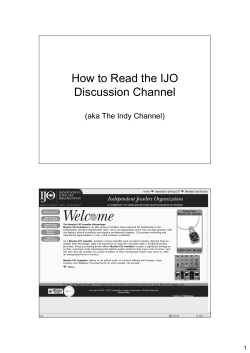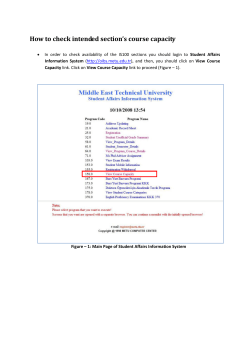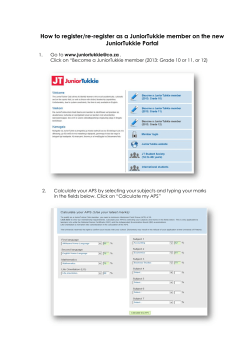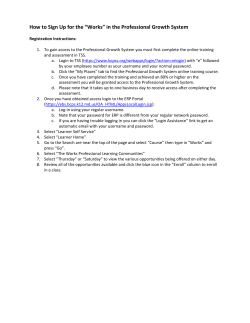
the 2015 EU Consumer Research Study
2015 Janrain Consumer Research UK, France, and Germany Consumer Identity and Mistargeting Identity-Driven Marketing Mistargeting continues to be ubiquitous and drives disengagement. DESPITE A MANTRA OF BETTER TARGETING, FULLY 95% OF EUROPEANS ARE MISTARGETED, ON PAR WITH US CONSUMERS. Q6: How often, if at all, have you experienced a situation where a company has sent you information, promotions, etc. that are not relevant to you? (n=651) 1 What drives this? How does it hurt your brand? 2 Marketers mistarget users in part because they provide fake data. +7327+ fakename@mail.com 73% of consumers admit to intentionally providing misinformation when creating accounts—up from 66% in 2014 Q4. If creating a new account at a website becomes tedious then people tend to not enter all of the information requested (leave some information blank) or intentionally enter incorrect information (sometimes to avoid being targeted for marketing programs). n=876 3 Marketers mistarget in a few ways. Types of mistargeting encountered 61% 40% 36% ‘An offer that clearly shows they do not know who I am’ ‘Mistakes made on basic information about me’ ‘Mixed info across different methods of communication’ Q6: How often, if at all, have you experienced a situation where a company has sent you information, promotions, etc. that are not relevant to you? (n=651) Q7: Below is a list of potential scenarios in which companies mistargeted their marketing efforts and were NOT successful in personalising the communication to their customers. Select all, if any, of the following that you have experienced first-hand. (n=651) 4 The dangers of mistargeted communications. 92% of European users react negatively to mistargeting in the following ways 48% 46% 34% 27% 18% 15% Automatically delete emails Unsubscribe from emails Categorise emails as ‘junk’ / ‘spam’ Are less likely to buy products Visit website less frequently Never visit website again The only major difference from US consumers: Europeans are 26% less likely to categorise mistargeted emails as junk. Q8: Please select from the following list all of the actions you have taken, if any, for companies that consistently mistarget you in their marketing efforts. Please select ALL that apply. (N=651) 5 The consequences of mistargeted communications. European audiences are notably intolerant of mistargeting 33% of customers will unsubscribe after only two or fewer mistargeted emails, compared with 37% in the US. 41% automatically delete or categorise as ‘junk’ emails after being mistargeted two or fewer times, compared to 36% in the US Q9: In general, how many of those mistargeted emails does it take in order for you to unsubscribe from the distribution list? (n=560) Q10: In general, how many mistargeted emails does it take before you start to delete a company’s emails without looking at them or perhaps categorise the emails as ‘junk’? (n=561) 6 The solution: End churn and detraction by accurately identifying customers with social login. 7 Your customers have already seen social login on other sites. Login with 88% have come across a site offering social login capability Q7B. In the past month, how often, if at all, have you come across a website that offered the ability to ‘log-in’ using one of your social network, email or online service accounts? n=876 8 Social login options improve customer perceptions about your company. 67% believe companies that offer social login are more up to date and innovative, and leave a positive impression, vs 57% for US consumers Q28: Below is a list of opinions. For each, please rate the degree to which you agree or disagree with the statement. (1-10 rating scale) (n=651) 9 Your customers use social login. Here’s why: Faster than traditional registration 49% 30% 12% Q21: Which of the following are the reason(s) why you use social login? (n=499) ***** One less password to remember Websites are more personalised 10 Adoption is lagging slightly behind the US, but user satisfaction is on par. % that have used social login 74% 66% 89% are satisfied with social login Q7F. Overall, how satisfied are you with the experiences you have had using social login? n=485 11 Simply by being transparent, companies could encourage more use. ‘What is most likely to encourage you to share your social profile with a website that you trust?’ 36% 33% 30% 20% ‘Company will not contact others in social network’ ‘Information is ONLY used to personalise experience, like content.’ ‘Company sends a free trial or gift card’ ‘Company provides a promotion’ Q24: Which of the following is most likely to encourage you to share your social media profile (e.g., gender, age, interests) with a website that you trust? (n=377) 12 The availability of social login greatly impacts behaviour for consumers who use it. 13 Higher social login use contributes directly to a few things, the first of which is return engagement. 67% are more likely to return to a website that remembers them without a username or password Q28: Below is a list of opinions. For each, please rate the degree to which you agree or disagree with the statement. (1-10 rating scale) (n=651) 14 Social login use also encourages engagement across devices. 56% would read more articles using their mobile phone or tablet if social login made it easier for them to login Q33: If ‘social login’ made the current process of logging-in to websites using your mobile phone, iPad or tablet computer easier, how would your behaviour using one of these mobile devices change, if at all? (n=651) 15 Finally, social login reduces the barriers to mobile ecommerce. 52% would make more purchases online using their mobile phone or tablet if social login made it easier for them to login Q33: If ‘social login’ made the current process of logging-in to websites using your mobile phone, iPad or tablet computer easier, how would your behaviour using one of these mobile devices change, if at all? (n=651) 16 Resulting identity-based relevancy has big payoffs for brands. If a company personalises the EU consumer’s web experience based on profile and interests… 45% are more likely to read articles or watch videos on the site 44% are more likely to spend more time on the site 40% are more likely to buy products/services on the site 37% are more likely to recommend the site to others 38% are more likely to make in-store purchase 35% are more likely to download a mobile app for the brand Q26: If a company personalises your experience and the information on their website by catering to your specific interests/preferences, how much more or less likely, if at all, are you to do the following? (n=648) 17 Differences by country among European Consumers 18 German consumers are less likely to defect from tedious login experiences. Percent who have provided inaccurate or incomplete information. 77% 81% 60% Percent who have left a site rather than reset password 85% 81% 74% Q12: How often have you intentionally left information out or entered incorrect information when creating a new account at a website or registering for the first time? (n=651) Q13: How often have you gone to a website, forgotten your username or password and decided to leave the website instead of going through the process of re-setting your password or answering security questions? (n=651) 19 UK consumers are most likely to use social log-in and perceive its value, but French consumers are close followers. Percent of consumers who use social login when available. 77% UK 74% FRANCE 66% GERMANY Q17: Many websites are starting to do things to eliminate the need for users to set up a new account, create a user name and password, fill out a lot of information which they may have already done at other sites, and/or remember the user name(s) and password(s) they created. One of the ways to make this process easier is to provide people that visit a website the option to ‘login’ using one of the accounts they already have with a social network, email provider or online service provider, such as Facebook, Gmail, Yahoo!, LinkedIn or PayPal. In general, do you think this option is helpful? Is this ‘social log-in’ an option you believe companies should offer to people? (n=651) Q19: When you are at a website that requires you to either create an account or gives you the option to log in using one of your social network, email or online accounts, how often do you use the social login option? (n=571) 20 French and German consumers are far more likely to ask their network to aid in purchase decisions. Percent of consumers who have asked for feedback from their social networks before makng a purchase 45% UK Q29: How often do you do the following? (n=651) 70% FRANCE 68% GERMANY 21 Mobile device usage varies significantly across countries but is still prevalent everywhere. Percent of consumers who use a smartphone or tablet to do the following: 44% 44% 54% 77% 61% 64% 59% Seek out competitive pricing information online while in a retail store 69% Purchase products or services 49% 56% 72% 70% 67% 64% 59% 59% Learn about products or services Play Games 77% 78% Watch Videos Read or post information on one or more of your social networks Q35: Please select which of the following activities, if any, that you have done using your smartphone, tablet or iPad over the past 30 days. Please check all that apply. (n=651) 22 Key Insights Insights are based on an online survey of 651 social media-active consumers in Europe, comprised of equal distribution among UK, French, and German consumers. That survey demonstrates: • Consumer defection in the face of mistargeted marketing is significant, on a par with US consumers. • Adoption of social login in Europe only slightly lags the US, with UK consumers demonstrating highest usage and affinity across all metrics. • Like US consumers, European consumers perceive social login as an ease-of-use solution, not a targeting solution, but the impact of ease-of-use is profound. • European consumers reward brands using social login with higher usage and loyalty. 23 Consumer Perceptions of Social Login research performed and prepared by Eric Anderson, Market Research Consultant 24 United Kingdom Respondent Profiles 5248 Gender 48% Age Most are 35—64 yrs 0% 65+ 52% Household Income Most earn <£40K/ yr £40K – £80K 26% £80K+ 7% 2% 14% 24% 13% Advanced Degree 28% 21% University Grad £25K – £40K 27% Some University 29% Tech School <£25K Education Most are college grads Secondary Grad 61% 35—64 Less than Secondary 38% 18—34 25 French Respondent Profiles 5248 Gender 48% Age Most are 35—64 yrs 0% 65+ 52% Household Income Most earn <€40k/ yr Education Most are college grads €40K – €80K 24% €80K+ 3% 2% 13% 27% 11% Advanced Degree 38% 18% University Grad €25K – €40K 29% Some University 32% Tech School <€25K Secondary Grad 65% 35—64 Less than Secondary 35% 18—34 26 German Respondent Profiles 5050 Gender 50% Age Most are 35—64 yrs 0% 65+ 50% Household Income Most earn <€80k/ yr €40K – €80K 34% €80K+ 10% 39% 9% 20% 3% Advanced Degree 28% 27% Univeristy Graduate €25K – €40K 2% Some University 22% Tech School <€25K Education Secondary Grad 67% 35—64 Less than Secondary 33% 18—34 27
© Copyright 2025









